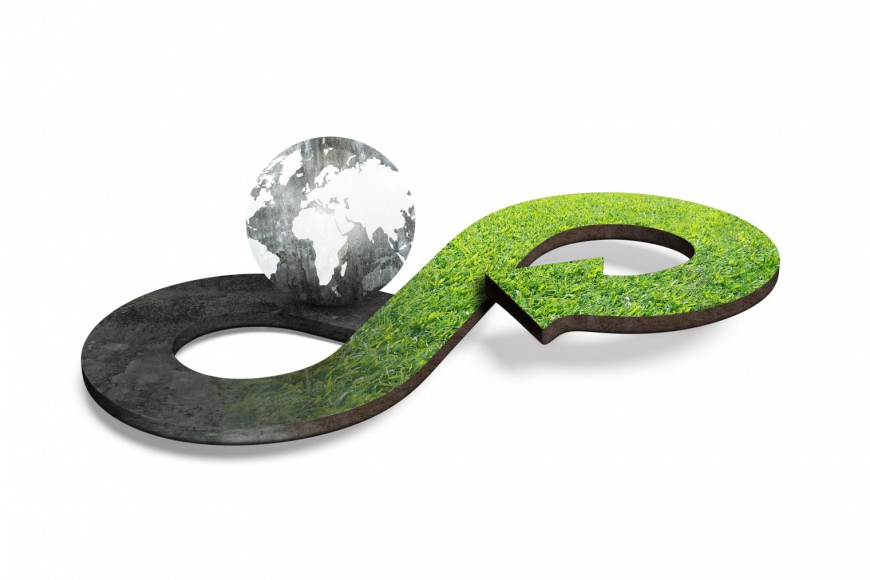Today, product companies are facing increasing pressure from both business and consumer stakeholders to create more responsible products—while also contending with tightening environmental regulations.
As a result, many are reworking their sustainability and business strategies to further reduce their environmental impact. But others are completely rewriting their approach—by throwing out the traditional “make, consume, waste” model and embracing the circular economy.
From a business perspective, we believe this response is by far the most strategic and profitable, with some core benefits being larger and more predictable revenues, enhanced customer loyalty and brand reputation, and product reliability. From an environmental and social perspective, it’s a win-win.
We wanted to take the time to highlight some of the brands diving head-first into the circular economy, so below are nine of those innovative companies, in no particular order.
1. Nike
As one of the world’s largest suppliers of athletic shoes and apparel, Nike recently announced a very ambitious goal: to double its business with half of the environmental impact. To accomplish this lofty goal, Nike is integrating circular economy principles into its strategy. And Nike’s efforts have not gone unnoticed.
The big brand received The Circulars 2017 Accenture Strategy Award for Circular Economy Multinational—a prestigious honor that it shared with another company on our list, Patagonia. The Circulars is an initiative of the World Economic Forum and the Forum of Young Global Leaders to recognize individuals and organizations making notable contributions to the circular economy.
“[Nike is] already on their journey,” The Circulars’ website states. “Today 71% of all Nike footwear and apparel incorporates recycled materials, and their designers use 29 high-performance materials made from factory scrap.”
2. Patagonia
Patagonia has taken major steps to integrate circular economy principles into its overall business strategy. As mentioned above, their efforts placed them as a co-winner of The Circulars 2017 Accenture Strategy Award for Circular Economy Multinational.
“Patagonia’s mission is to build the best product, cause no unnecessary harm and use business to inspire and implement solutions to the environmental crisis,” The Circulars’ website describes. “By ensuring the usable life of its products are extended, Patagonia can reduce related carbon, waste and water footprints by up to 20-30 percent per person (WRAP, 2012) simply because we’re making and throwing away less.”
In addition, another interesting component of Patagonia’s circular commitment is its “Worn Wear” program.
“One of the most responsible things we can do as a company is to make high-quality stuff that lasts for years and can be repaired,” Patagonia says on its website. “[The Worn Wear program] keeps your gear in action longer and provides an easy way to recycle Patagonia garments when they’re beyond repair.”
3. Speedo
In August 2015, Speedo USA dove into the circular economy by launching a new initiative to turn fabric scraps generated in its factories into full swimsuits.
To do this, Speedo partnered with Italy-based Aquafil to transform the fabric scraps back into nylon, a fabric that has been named Econyl. As a result, the brand launched the Speedo Powerflex Eco swimwear line, according to GreenBiz.
Not only is the new swimwear line reducing waste, but Speedo has been able to deliver a high-quality product at an affordable price. According to GreenBiz, the collection is priced between $40 and $74, which is in line with Speedo’s existing line.
4. Dell
Dell published its first Environmental Progress report nearly 20 years ago. Now, the technology giant is working toward achieving its 2020 Legacy of Good Plan, which includes goals such as reducing energy intensity by 80% and using packaging that is 100% compostable by the year 2020.
When it comes to circular economy, Dell recently expanded its closed-loop recycled plastic supply chain and introduced reclaimed carbon fiber source materials into some of its products, according to GreenBiz.
“One thing customers frequently explain is that they want products that are better for the environment, but they don’t want to pay more and it cannot affect performance,” Dell explains on its website. “The closed-loop plastics supply chain delivers exactly that—in fact, the closed-loop process delivers an energy-efficient product made from recycled content that is nominally less expensive, with the potential to show greater cost savings as the program scales.”
5. Method
In just a few short years, Method has become one of the largest “green” cleaning product companies.
“When it comes to sourcing and making ingredients, ‘responsible’ is our middle name,” the company’s website says.
The company’s entire mission is rooted in using its business for social and environmental good, employing a number of circular economy principles to achieve its goals.
“We are working to reduce the use of non-renewable materials like petroleum across our product line—from our bottling to our formulations,” the company’s website states. “Our progress so far? We make our core cleaning bottles from 100% recycled plastic, our laundry bottles from 50% recycled plastic and the vast majority of our formulations come from renewably sourced ingredients.”
6. Energizer
Energizer has been working to become a more sustainable and environmentally responsible business for decades through the removal harmful materials such as Mercury and Cadmium from its products, and other efforts. But in 2015, Energizer introduced the world’s first AA battery—Energizer EcoAdvanced—made with 4% recycled batteries. Today, the EcoAdvanced line also includes AAA batteries, too.
“[The Energizer EcoAdvanced product] is another step in our journey to bring performance and responsibility to the world,” the company’s website says.
While 4% may not sound like much, batteries are incredibly complex. As a result, a tremendous scientific effort was needed to make EcoAdvanced happen.
“The company had to develop new methods for refining used materials to make them as pure as possible so that they could be used alongside virgin materials in new batteries,” a GreenBiz article states.
7. Ford
Sustainability and circular economy principles are an integral part of Ford’s business.
“Our Blueprint for Sustainability goes beyond improved fuel economy and reduced CO2 emissions to define sustainability as a business model that creates value by preserving and enhancing environmental, social and financial capital,” the car maker’s website says.
Ford takes a Life Cycle Approach to creating its products to understand, assess and reduce adverse environmental impacts. One piece of that approach is using recycled, renewable and recyclable materials. In some cases, Ford recycles materials such as aluminum or seat fabric through closed-loop recycling. Ford is also working on transforming post-consumer laundry detergent container and milk jugs into blow-molded automotive components.
8. BASF
BASF’s sustainability mantra is “We create chemistry for a sustainable future”—and this is certainly evident in its commitment to using renewable resources in production.
In partnership with TÜV SÜD, the German chemical company developed the “biomass balance method”, an approach that replaces fossil resources with renewable resources.
“In this process, renewable raw materials are used as feedstock at the very beginning of production in the Verbund, and allocated to the respective sales products using the novel certification method,” the company’s website explains. “The certified products thus contribute to sustainable development by saving fossil resources and reducing greenhouse gas emissions.”
In addition, BASF’s has developed ecovio, a certified compostable and biodegradable bioplastic, and invested in other technologies to reduce energy use and emissions during production.
9. Looptworks
Looptworks is a startup with a simple mission: to use what already exists. All the materials Looptworks uses to create products were at one time destined to end up in landfill.
“We intercept and utilize industry excess materials, transforming them into new, useful products—a process known as upcycling,” the company’s website says. “Our sustainable, eco-friendly products are made in limited editions, and in the process save materials from landfills or incinerators.”
A Shout Out to Minnesota Companies
Minnesota is home to some well-known product companies—as well as Antea Group’s own U.S. headquarters. Recently, several Minnesota-based businesses and organizations formed the Minnesota Sustainable Growth Coalition, a project of the Environmental Initiative. The goal of the coalition is to harness their collective expertise to advance “the next frontier of corporate sustainability”—the circular economy.
Current members include: 3M, Ackerberg, Andersen Corporation, Aveda, Best Buy, Cargill, Center for Energy and Environment, Dow, Ecolab, Ever-Green Energy, Fairview, Fredrikson & Byron P.A., General Mills, Greater MSP, Great Plains Institute, Great River Energy, HealthPartners, HGA, Hormel Foods, Institute on the Environment – University of Minnesota, Life Time, Medtronic, Metropolitan Airports Commission, Metropolitan Council, Minnesota Department of Administration, Target, Tennant Company, Thomson Reuters, Tunheim, Uponor, Wenck and Xcel Energy.
Ready for a Rewrite?
Companies, organizations and communities of all sizes are embracing the circular economy. Is your company ready? Learn about four challenges you may face, as well as possible solutions, that can help you achieve your goals.
Want more news and insights like this?
Sign up for our monthly e-newsletter, The New Leaf. Our goal is to keep you updated, educated and even a bit entertained as it relates to all things EHS and sustainability.
Get e-NewsletterHave any questions?
Contact us to discuss your environment, health, safety and sustainability needs today.





